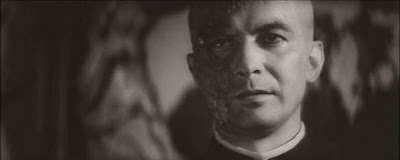During the golden age of Japanese film, Shôchiku was Japan's Tiffany studio, home to Ozu, Mizoguchi, Naruse, and Kinoshita. It's singularly weird to see their familiar Mount Fuji logo attached to schlocky horror movies. And yet, during the 1960s, horror came to Shôchiku, as the title of Criterion's boxed set of their horror movies announces. The Living Skeleton (Kyûketsu dokuro-sen, 1968, directed by Hiroshi Matsuno) is a fun example, though it's quaint even in the mainstream of Japanese horror. I mean, Japan was already making horror masterpieces like The Face of Another and Kwaidan, so it's not like this film appears in a vacuum. In spite of that, it's strangely forward-looking, anticipating the J-horror boom of the 1990s and John Carpenter's The Fog.
The film opens with a massacre, as the crew and passengers of the Dragon King are mowed down by bandits after the gold bullion in its hold, leaving the ship to drift, lost to the ocean. The only real opposition they encounter is Dr. Nishizato and his wife, Yoriko, who plead for the lives of their shipmates to no avail. Three years pass, and the bandits have made what they will of their booty. Yoriko's twin sister, Saeko, is living with a priest and dating Mochizuki, who owns a small cafe. On a diving jaunt in a motor boat, Saeko and Mochizuki encounter the skeletal remains of the bandits' victims, and then encounter the Dragon King itself, surrounded by a sinister fogbank. Boarding the ship, they encounter what appears to be Yoriko's ghost. Soon, the bandits begin to meet bad ends, culminating in a confrontation between the hideously scarred Tanuma, the leader of the bandits who has been living a quiet life in disguise, and Yoriko's ghost. They meet their fates aboard the Dragon King itself...
This film is bonkers. It has awful special effects--the Dragon King is often filmed as a miniature that's more unconvincing than anything in a given Godzilla movie--and the skeletons who lurk beneath the sea are aesthetically faked. I like to think that the skeletons in this film are in mid-transformation into Heike crabs. Their skulls have that same scowling samurai face. But in spite of all that, it has a go for broke way of charging through its narrative that pushes such considerations to the side. I'm told that this is the kind of film that Shintoho Studios, by then defunct, specialized in in the previous decade, but to my eye, it most resembles the films of the Mexican director, Chano Ureta, whose films are similarly infected with a willingness to charge after ridiculous tangents and to hell with coherent plotting. Certainly, the mad-scientist conclusion of the film is straight out of The Black Pit of Dr. M.
Filmed in stark black and white, this film is often lovely to look at. Visually, it sometimes resembles films by Nagisa Oshima or Masahiro Shinoda, but it also sometimes looks like the exploitation films of the 1970s. The disfigurement of Tanuma, for instance, and his status as the hidden villain of the piece concealed in plain sight, is straight out of a Meiko Kaji revenge flick. Tanuma's face is also emblematic of some dark undercurrents in the Japan of the fifties and sixties: he looks like a burn victim from Hiroshima, and equating his disfigurement with evil is a reminder that the survivors were sometimes shunned as unclean. But I digress.
The frequent appearances of Yoriko as a ghost can be explained away as shenanigans with twins if you like, especially given the twist at the end of the film, but the filmmakers inventively puts her in places where that doesn't wash. The way she appears in reflections--particularly in one memorable sequence on a train where she's reflected in a window looking out at the night--is the sort of visual strategy of the ghost films that derive from The Ring. This stuff works better than the elements that require elaborate special effects, which is one reason ghost movies became so popular a couple of decades later. There's an image near the end of the film that keeps echoing in my mind, too, in which the villain ends up dragging a corpse with him that he can't shake. This is an image that recurs in my own experience of Asian cinema, showing up again at the beginning of the third Female Prisoner Scorpion film, and then again recently in Drug War. As a signifier of guilt, it's a hell of a trope.
In any case, The Living Skeleton jumps the rails early and never really returns. This isn't a criticism, really. I was on board for the ride from the get go.
Current Challenge tally:
Total Viewings: 21
First Time Viewings: 17
Around the Web:
Fascination with Fear takes a look at disc jockeys in horror, a surprisingly hazardous profession.
The Celluloid Dreamer cruises down Sorority Row.
Justin at The Bloody Pit of Horror tells Zoltan: Hound of Dracula to heel.
Anna over at Bemused and Nonplussed checks in to the Overlook Hotel for a two-fer review of The Shining and Room 237.
Friend of the Blog, Stacia, over at She Blogged by Night joins the Vincent Price blogathon with a look at The Tomb of Ligeia.




















No comments:
Post a Comment